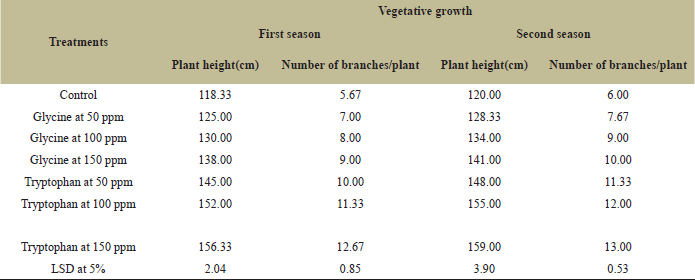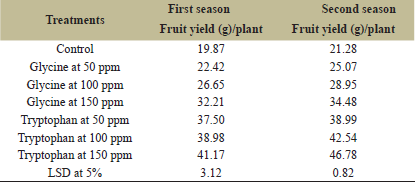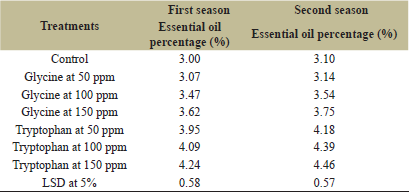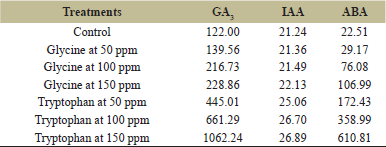1. INTRODUCTION
Caraway (Carum carvi L.), a member of the Apiaceae family, is considered as one of the main medicinal plants and is an annual herbaceous plant. The main active components of caraway essential oil, which give the odor and flavor characteristics, are carvone from 47% to 81.17% and limonene from 9.4% to 48.7% [1]. The essential oil of caraway fruits has several medicinal uses as carminative, stomachic, and antispasmodic [2].
Amino acids are essential for promoting plant cell growth by building protein units as the major components of living cells [3]. Amino acids play an important role in inducing amines, purines, pyrimidines, alkaloids, vitamins, enzymes, terpenoids, and others [4]. Also, it plays a vital role in eliminating ammonia from the cell and protecting the plant from ammonia toxicity [5]. Moreover, previous studies have investigated the apparent positive effects of amino acids on plant growth and yield under abiotic stress [6]. Other studies have reported that the external application of amino acids induces stimulation influences of growth on several crops observed by using the exogenous implementation of amino acids [7,8]. The use of amino acids as a foliar application significantly increased the essential oil percentage and yield of the lemongrass plant [9]. Similar results were obtained from [10,11] on some medicinal plants.
Glycine acid acts as a necessary function in plant growth and the building of chlorophyll. It also can simplify the Fe, Zn, Mn, and Cu absorption for the plant [12]. The molar mass of glycine is 75 g mol−1, which is considered a minor biological amino acid and proteinogenic amino acid in cells [13].
Tryptophan is the precursor of indole acetic acid (IAA), a phytohormone present in the root of plants [14]. It organizes osmosis and prevents the detrimental influence of heavy metals [15]. Foliar application of L-tryptophan enhanced the essential oil and its main constituents of thyme (Thymus vulgaris) aerial part [16] and geranium (Pelargonium graveolens) [17].
The purpose of this study was to explore the effects of exogenous application of two amino acids (glycine and tryptophan) individually on growth, flowering, fruit yield, production of essential oil, and some phytohormone content of caraway (C. carvi L) plants.
2. Materials and Methods
This study was conducted at the Experimental Farm of Medicinal and Aromatic Plants Research in El-Kanater El-Khairia, Egypt, during two seasons (2019/2020 and 2020/2021).
The fruits (seeds) of caraway (C. carvi L.) were obtained from the Experimental Farm of Medicinal and Aromatic Plants in El-Kanater El-Khairia. The fruits were sown on October 17 into plots 2.4 × 2 m consisting of 4 rows and containing 32 plants (8 plant/row) at a distance of 25 cm between hills and a distance of 60 cm between rows in the two seasons. The experiment was designed in complete randomized blocks. The experiment consists of seven treatments, with three replicates.
Caraway plants were fertilized with the recommended dose of chemical fertilizers (NPK) as follow: calcium superphosphate (15% P2O5) was added during soil preparation, whereas ammonium sulfate (20.5% N) and potassium sulfate (48% K2O) doses per feddan were applied at two equal splits, after 45 and 75 days from sowing. The irrigation system used in the experiment is flood irrigation.
Tryptophan (99%) and glycine (98%) were obtained from EL-Gomhoriya Company for Trading Chemicals and Medical Appliances. Treatments were applied as foliar at concentrations of 50, 100, and 150 ppm for tryptophan and glycine alone; the control plants were only sprayed with tap water. Plants were sprayed twice; the first dose was sprayed at age 45 days after sowing, and the second was done after 2 weeks from the first one using a hand atomizer.
THE EXPERIMENT DATA RECORDED WERE
2.1. Vegetative growth parameters
Plant samples were taken in both seasons randomly. Data recorded were plant height (cm) and the number of branches/plant.
2.2. Flowering
The number of umbels/plants was obtained at the flowering stage in both seasons.
2.3. Yield
At the harvest stage, fruit yield (g)/plant was recorded in both seasons.
2.4. Essential oil analysis
Essential oil percentage was determined according to [18]. The main composition of caraway fruits essential oil (carvone and limonene) was determined by subjecting oil samples of the second season to gas liquid chromatography analysis according to [19,20].
2.5. Plant hormones
Gibberellin (GA3), IAA, and abscisic acid (ABA) in young leaves of caraway plant were determined at 80 days after planting in the second season of 2020/2021. The extraction method was essentially the same as that used in [21] and described in [22], while the determination was carried out according to [23].
2.6. Statistical Analysis
The reported data were statistically analyzed according to [24] using LSD at 5%.
3. RESULTS
3.1. Vegetative Growth
Data presented in Table 1 show that, in the general foliar application of tryptophan and glycine at 50, 100, and 150 ppm, each of them significantly improved (the plant height and the number of branches/plant) compared with untreated plants in the first and second seasons. Furthermore, the application of tryptophan at 150 ppm gave the highest values recorded of plant growth characters compared to other treatments and the control in the two seasons.
3.2. Flowering
All concentrations of tryptophan and glycine (50, 100, and 150 ppm) increased the number of umbels per plant significantly compared with the control in both seasons, as shown in Table 2. Results showed that glycine at the concentration of 150 ppm recorded a high number of umbels/plant (48 and 54) compared to untreated plants and two levels of glycine (50 and 100 ppm). Overall, the highest values were obtained from the plants that received tryptophan at 150 ppm giving the number of umbels per plant (73 and 78) in the two seasons compared to other treatments.
 | Table 1: Effect of tryptophan and glycine on vegetative growth of caraway plants during 2019/2020 and 2020/2021 seasons. [Click here to view] |
3.3. Fruit yield
It was observed that all spraying treatments of tryptophan or glycine at concentrations of 100 and 150 ppm had a significant effect on the fruit yield of the caraway plant compared to the control in the two seasons (Table 3). The application of tryptophan at a high dose (150 ppm) gave the heaviest fruit yield per plant compared to untreated plants and two rates of tryptophan in both seasons. Moreover, glycine at the concentration of 150 ppm occupied the second rank in this concern.
3.4. Essential Oil Production
3.4.1. Essential oil percentage
The effect of foliar spray caraway plants with glycine or tryptophan on the essential oil content in caraway fruits is presented in Table 4. In both seasons, data showed that the high concentration of glycine or tryptophan (150 ppm) significantly increased the essential oil percentage compared to the control. The best results were obtainable by using glycine at 150 ppm, which recorded 3.62% and 3.75% in the first and second seasons, respectively. Furthermore, foliar application of tryptophan at the concentration of 150 ppm gave the highest values (4.24% and 4.46%).
 | Table 2: Effect of tryptophan and glycine on a number of umbels/plants of caraway plants during 2019/2020 and 2020/2021 seasons. [Click here to view] |
 | Table 3: Effect of tryptophan and glycine on fruit yield/plant of caraway plants during 2019/2020 and 2020/2021 seasons. [Click here to view] |
 | Table 4: Effect of tryptophan and glycine on essential oil percentage of caraway plants during 2019/2020 and 2020/2021 seasons. [Click here to view] |
It is worth noticing that the aforementioned parameters of caraway plants showed a positive response to tryptophan compared to glycine during the two seasons.
3.4.2. Essential oil constituents
Data presented in Table 5 show that the main constituents of the essential oil of caraway were carvone and limonene, which accounted for 90.19% to 96.78% of the total oil composition. The highest value was 96.78%, obtained by foliar spray plants with tryptophan at a concentration of 150 ppm; however, the lowest was 90.19% obtained by untreated plants.
The highest value of limonene was 46.39% using tryptophan at 100 ppm, whereas the lowest value of limonene was 31.04% obtained by untreated plants.
Also, the obtained results revealed that the highest value of carvone was 61.68%, obtained by foliar application of tryptophan at the concentration of 150 ppm; on the other hand, the lowest value of carvone was 49.86% obtained by foliar application of tryptophan at the concentration of 50 ppm.
3.5. Phytohormones
Concerning the effect of treatments on phytohormones, the results showed that all treatments led to increasing the phytohormones content of plants. Also, data presented in Table 6 show that foliar spray plants with tryptophan at the concentration of 150 ppm gave the highest concentration of GA3, IAA, and ABA, which is 1062.24, 26.89, and 610.81 μg/100 g FW, respectively. On the other hand, the untreated plants have the minimum concentration of phytohormones.
4. DISCUSSION
Amino acids are necessary for cell growth because they act as coenzymes and precursors of plant hormones and enhance the photosynthesis process rate [25]. This study investigated the effects of foliar spray with amino acids (tryptophan and glycine) at concentrations of 50, 100, and 150 ppm. This study proved that foliar spray with amino acids increased growth characters, flowering, fruit yield, and essential oil production of caraway plants. These findings are consistent with a previous study that demonstrated the positive effect of amino acids on growth [4]. It showed that amino acids could be the main source of carbon and energy in plants when carbohydrates become limited, releasing the ammonia and organic acid structure from which the amino acid was originally formed. The organic acids then enter the Krebs cycle to release energy during respiration.
Likewise, other studies [26,27] reported that amino acids are of particular importance to plant producers because of their ultimate roles in plant metabolism. Amino acids are the building blocks of proteins synthesis and precursors for many other molecules that perform an important function in plants. Amino acids participate in other organic compounds’ synthesis, like protein, amines, alkaloids, vitamins, enzymes, terpenoids, and plant hormones that control diverse plant processes.
Glycine is one of the main amino acids vital for the biosynthesis of protein in plant cells [28–30]. In our study, it is worth noticing that foliar spray of glycine at different concentrations, mostly at 150 ppm, leads to a significant increase in growth parameters. The potential effect of glycine, especially at high concentrations, may be ascribed to its incorporation with nutrient elements to produce chelates and then facilitate nutrient absorption in plants. Foliar spray of glycine can increase its endogenous content in plant tissues and improve growth and quality [13]. Likewise, a subsequent study has also reported that foliar application of glycine was the best treatment for achieving the highest flower yield and essential oil and the most prolonged flowering [31].
 | Table 5: Effect of tryptophan and glycine on limonene and carvone of essential oil in fruits of caraway plants during 2020/2021 season. [Click here to view] |
 | Table 6: Effect of tryptophan and glycine on phytohormones (μg/100 g FW) of caraway plant leaves during 2020/2021 season. [Click here to view] |
On the other hand, it was observed that spraying caraway plants with tryptophan at a high concentration of 150 ppm was the most effective treatment in this study. Spraying tryptophan increased growth parameters, most likely due to the amino acid tryptophan’s role in plants as a precursor for IAA biosynthesis. IAA can regulate and stimulate various aspects of plant growth related to cell division and elongation; thus, the plant height could be increased [32]. In addition, it plays a role in the decomposition of dead cells into proteins, thereby stimulating plant growth and flowering of the plant [33]. According to [34], foliar-applied tryptophan at higher concentrations increased GA3, IAA, cytokinin, and ABA contents in leaves.